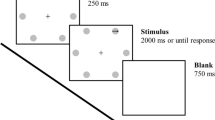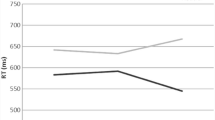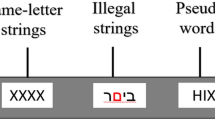Abstract
The implications of an ideomotor approach to action control were investigated. In Experiment 1, participants made manual responses to letter stimuli and they were presented with response-contingent color patches, i.e., colored action effects. This rendered stimuli of the same color as an action’s effect effective primes of that action, suggesting that bilateral associations were created between actions and the effects they produced. Experiment 2 combined this set-up with a manual Stroop task, i.e., participants responded to congruent, neutral, or incongruent color-word compounds. Standard Stroop effects were observed in a control group without action effects and in a group with target-incompatible action effects, but the reaction time Stroop effect was eliminated if actions produced target-compatible color effects (e.g., blue word→left key→blue patch). Experiment 3 did not replicate this interaction between target-effect compatibility and color-word congruency with color words as action effects, which rules out semantically based accounts. Theoretical implications for both action-effect acquisition and the Stroop effect are discussed. It is suggested that learning action effects, the features of which overlap with the target, allows and motivates people to recode their actions in ways that make them more stimulus-compatible. This provides a processing shortcut for translating the relevant stimulus into the correct response and, thus, shields processing from the impact of competing word distractors.




Similar content being viewed by others
Notes
Alternatively, one might argue that action effects have a stronger impact on the association between target and response because they are both colors and, thus, share format and modality. This reasoning—which we will find again in the discussion of translation models—would imply the exactly opposite outcome, i.e., the compatible-mapping group should produce the smallest Stroop effect. However, neither version of the dimensional overlap model or any of the interactive action models discussed address the issue of format- or modality-specific stimulus-response overlap (see Lu, 1997, for a broader discussion), which renders this kind of reasoning overly speculative. However, Sugg and McDonald (1994) have presented a hybrid model combining aspects of the Cohen et al. (1990) model with aspects of translation models à la Glaser and Glaser (1989), and this model would be well equipped to deal with format-specific effects.
It is an interesting question whether the codes for left and blue (and for right and green) can also become directly associated. This hypothesis is not only suggested by a generalization of the action-concept approach (Hommel, Müsseler, Aschersleben, & Prinz, 2001), it also seems to stand empirical testing (Hommel & Colzato, in press; Hommel, 1998b, 2003b).
References
Ansorge, U. (2002). Intention-response compatibility. Acta Psychologica, 109, 285–299.
Bargh, J. A. (1997). The automaticity of everyday life. In R. S. Wyer, Jr. (Ed.), The automaticity of everyday life: Advances in social cognition (Vol. 10, pp. 1–61). Mahwah, NJ: Erlbaum.
Beckers, T., De Houwer, J., & Eelen, P. (2002). Automatic integration of non-perceptual action effect features: The case of the associative affective Simon effect. Psychological Research, 66, 166–173.
Cohen, J. D., Dunbar, K., & McClelland, J. L. (1990). On the control of automatic processes: A parallel distributed processing account of the Stroop effect. Psychological Review, 97, 332–361.
Craft, J. L., & Simon, J. R. (1970). Processing symbolic information from a visual display: Interference from an irrelevant directional cue. Journal of Experimental Psychology, 83, 415–420.
Craighero, L., Fadiga, L., Rizzolatti, G., & Umiltá, C. (1999). Action for perception: A motor-visual attentional effect. Journal of Experimental Psychology: Human Perception and Performance, 25, 1673–1692.
De Jong, R., Liang, C. C., & Lauber, E. (1994). Conditional and unconditional automaticity: A dual process model of effects of spatial stimulus response correspondence. Journal of Experimental Psychology: Human Perception and Performance, 20, 731–750.
Dunbar, K., & MacLeod, C. M. (1984). A horse race of a different color: Stroop interference patterns with transformed words. Journal of Experimental Psychology: Human Perception and Performance, 10, 622–639.
Duncan, J. (1993). Selection of input and goal in the control of behavior. In A. Baddeley & L. Weiskrantz (Eds.), Attention: Selection, awareness, and control (pp. 53–71). Oxford: Oxford University Press.
Duncan, J. (1995). Attention, intelligence, and the frontal lobes. In M. Gazzaniga (Ed.), The cognitive neurosciences (pp. 721–733). Cambridge, MA: MIT Press.
Elsner, B., & Hommel, B. (2001). Effect anticipation and action control. Journal of Experimental Psychology: Human Perception and Performance, 27, 229–240.
Elsner, B., & Hommel, B. (in press). Contiguity and contingency in the acquisition of action effects. Psychological Research.
Elsner, B., Hommel, B., Mentschel, C., Drzezga, A., Prinz, W., Conrad, B., et al. (2002). Linking actions and their perceivable consequences in the human brain. NeuroImage, 17, 364–372.
Glaser, W. R., & Glaser, M. O. (1989). Context effects in Stroop-like word and picture processing. Journal of Experimental Psychology: General, 118, 13–42.
Goschke, T. (2000). Involuntary persistence and intentional reconfiguration in task-set switching. In S. Monsell & J. Driver (Eds.), Attention and Performance XVIII: Control of cognitive processes (pp. 331–355). Cambridge, MA: MIT Press.
Greenwald, A. G. (1970). Sensory feedback mechanisms in performance control: With special reference to the ideo-motor mechanism. Psychological Review, 77, 73–99.
Harless, E. (1861). Der Apparat des Willens. Zeitschrift für Philosophie und philosophische Kritik, 38, 50–73.
Hazeltine, E. (2002). The representational nature of sequence learning: Evidence for goal-based codes. In Prinz, W., & Hommel, B. (Eds.), Common mechanisms in perception and action: Attention & Performance XIX (pp. 673–689). Oxford: Oxford University Press.
Hoffmann, J., Sebald, A., & Stöcker, C. (2001). Irrelevant response effects improve serial learning in serial reaction time tasks. Journal of Experimental Psychology: Learning, Memory, and Cognition, 27, 470–482.
Hommel, B. (1993). Inverting the Simon effect by intention: Determinants of direction and extent of effects of irrelevant spatial information. Psychological Research, 55, 270–279.
Hommel, B. (1994). Spontaneous decay of response code activation. Psychological Research, 56, 261–268.
Hommel, B. (1995). Stimulus-response compatibility and the Simon effect: Toward an empirical clarification. Journal of Experimental Psychology: Human Perception and Performance, 21, 764–775.
Hommel, B. (1996). The cognitive representation of action: Automatic integration of perceived action effects. Psychological Research, 59, 176–186.
Hommel, B. (1997a). Toward an action-concept model of stimulus-response compatibility. In B. Hommel & W. Prinz (Eds.), Theoretical issues in stimulus-response compatibility (pp. 281–320). Amsterdam: North-Holland.
Hommel, B. (1997b). Interactions between stimulus-stimulus congruence and stimulus-response compatibility. Psychological Research, 59, 248–260.
Hommel, B. (1998a). Perceiving one’s own action—and what it leads to. In J. S. Jordan (Ed.), Systems theory and apriori aspects of perception (pp. 143–179). Amsterdam: North-Holland.
Hommel, B. (1998b). Event files: Evidence for automatic integration of stimulus-response episodes. Visual Cognition, 5, 183–216.
Hommel, B. (2003a). Acquisition and control of voluntary action. In S. Maasen, W. Prinz, & G. Roth (Eds.), Voluntary action: An issue at the interface of nature and culture (pp. 34–48). Oxford: Oxford University Press.
Hommel, B. (2003b). Feature integration across perception and action: Event files affect response choice. Manuscript submitted for publication.
Hommel, B., & Colzato, L. S. (in press).Visual attention and the temporal dynamics of feature integration. Visual Cognition.
Hommel, B., & Elsner, B. (2000). Action as stimulus control. In A. Schick, M. Meis, & C. Reckhardt (Eds.), Contributions to psychological acoustics: Results of the 8th Oldenburg Symposium on Psychological Acoustics (pp. 403–424). Oldenburg: Universität Oldenburg.
Hommel, B., & Prinz, W. (Eds.) (1997). Theoretical issues in stimulus-response compatibility. Amsterdam: North-Holland.
Hommel, B., & Schneider, W. X. (2002). Visual attention and manual response selection: Distinct mechanisms operating on the same codes. Visual Cognition, 9, 392–420.
Hommel, B., Pösse, B., & Waszak, F. (2000). Contextualization in perception and action. Psychologica Belgica, 40, 227–245.
Hommel, B., Müsseler, J., Aschersleben, G., & Prinz, W. (2001). The theory of event coding (TEC): A framework for perception and action planning. Behavioral and Brain Sciences, 24, 849–878.
Hommel, B., Alonso, D., & Fuentes, L. J. (in press). Acquisition and generalization of action effects. Visual Cognition.
James, W. (1890). The principles of psychology. New York: Dover.
Kane, M. J., & Engle, R. W. (2003a). Working memory capacity and the control of attention: The contributions of goal neglect, response competition, and task set to Stroop interference. Journal of Experimental Psychology: General, 132, 47–70.
Kane, M. J., & Engle, R. W. (2003b). The role of prefrontal cortex in working-memory capacity, executive attention, and general fluid intelligence: An individual differences perspective. Psychonomic Bulletin & Review, 9, 637–671.
Keele, S. W. (1972). Attention demands of memory retrieval. Journal of Experimental Psychology, 93, 245–248.
Koch, I., & Kunde, W. (2002). Verbal response-effect compatibility. Memory & Cognition, 30, 1297–1303.
Kornblum, S. (1994). The way irrelevant dimensions are processed depends on what they overlap with: The case of Stroop- and Simon-like stimuli. Psychological Research, 56, 130–135.
Kornblum, S., Hasbroucq, T., & Osman, A. (1990). Dimensional overlap: Cognitive basis for stimulus response compatibility a model and taxonomy. Psychological Review, 97, 253–270.
Kornblum, S., Stevens, A., Whipple, A., & Requin, J. (1999). The effects of irrelevant stimuli. I. The time-course of stimulus-stimulus and stimulus-response consistency effects with Stroop-like stimuli, Simon-like tasks, and their factorial combinations. Journal of Experimental Psychology: Human Perception and Performance, 25, 688–714.
Kunde, W. (2001). Response-effect compatibility in manual choice reaction tasks. Journal of Experimental Psychology: Human Perception and Performance, 27, 387–394.
Kunde, W., Hoffmann, J., & Zellmann, P. (2002). The impact of anticipated action effects on action planning. Acta Psychologica, 109, 137–155.
Logan, G. D., & Zbrodoff, N. J. (1979). When it helps to be misled: Facilitative effects of increasing the frequency of conflicting stimuli in a Stroop-like task. Memory & Cognition, 7, 166–174.
Lotze, R. H. (1852). Medizinische Psychologie oder die Physiologie der Seele. Leipzig, Germany: Weidmann’sche Buchhandlung.
Lu, C.-H. (1997). Correspondence effects for irrelevant information in choice-reaction tasks: Characterizing the S-R relations and the processing dynamics. In B. Hommel, & W. Prinz (Eds.), Theoretical issues in stimulus-response compatibility (pp. 85–117). Amsterdam: North-Holland.
Lu, C.-H., & Proctor, R. W. (1995). The influence of irrelevant location information on performance: A review of the Simon and spatial Stroop effects. Psychonomic Bulletin & Review, 2, 174–207.
MacLeod, C. M. (1991). Half a century of research on the Stroop effect: An integrative review. Psychological Bulletin, 109, 163–203.
MacLeod, C. M., & MacDonald, P. A. (2000). Interdimensional interference in the Stroop effect: Uncovering the cognitive and neural anatomy of attention. Trends in Cognitive Sciences, 4, 383–391.
McClain, L. (1983). Effects of response type and set size on Stroop color-word performance. Perceptual and Motor Skills, 56, 735–743.
Meiran, N. (2000a). Reconfiguration of stimulus task-sets and response task-sets during task-switching. In S. Monsell and J. Driver (Eds.), Control of cognitive processes: Attention and Performance XVIII. Cambridge, MA: MIT Press.
Meiran, N. (2000b). Modeling cognitive control in task-switching. Psychological Research, 63, 234–249.
Müsseler, J., & Hommel, B. (1997). Blindness to response-compatible stimuli. Journal of Experimental Psychology: Human Perception and Performance, 23, 861–872.
Phaf, R. H., Van der Heijden, A. H. C., & Hudson, P. T. W. (1990). SLAM: A connectionist model for attention in visual selection tasks. Cognitive Psychology, 22, 273–341.
Prinz, W. (1987). Ideo-motor action. In H. Heuer & A. F. Sanders (Eds.), Perspectives on perception and action (pp. 47–76). Hillsdale, NJ: Erlbaum.
Pritchatt, D. (1968). An investigation into some of the underlying associative verbal processes of the Stroop colour effect. Quarterly Journal of Experimental Psychology, 20, 351–359.
Simon, J. R., & Berbaum, K. (1990). Effect of conflicting cues on information processing: The ‘Stroop effect’ vs. the ‘Simon effect’. Acta Psychologica, 73, 159–170.
Simon, J. R., & Rudell, A. P. (1967). Auditory S-R compatibility: The effect of an irrelevant cue on information processing. Journal of Applied Psychology, 51, 300–304.
Simon, J. R., & Sudalaimuthu, P. (1979). Effects of S-R mapping and response modality on performance in a Stroop task. Journal of Experimental Psychology: Human Perception and Performance, 5, 176–187.
Simon, J. R., Paullin, C., Overmyer, S. P., & Berbaum, K. (1985). Reaction time to word meaning and ink color of laterally presented Stroop stimuli: Effects of handedness and sex. International Journal of Neuroscience, 28, 21–33.
Spieler, D. H., Balota, D. A., & Faust, M. E. (1996). Stroop performance in healthy younger and older adults and in individuals with dementia of the Alzheimer’s type. Journal of Experimental Psychology: Human Perception and Performance, 22, 461–479.
Stroop, J. R. (1935). Studies of interference in serial verbal reactions. Journal of Experimental Psychology, 28, 643–662.
Sugg, M. J., & Mc Donald, J. E. (1994). Time course of inhibition in color-response and word-response versions of the Stroop task. Journal of Experimental Psychology: Human Perception and Performance, 20, 647–675.
Umiltà, C., & Nicoletti, R. (1990). Spatial stimulus-response compatibility. In R. W. Proctor & T. G. Reeve (Eds.), Stimulus-response compatibility (pp. 89–116). North-Holland: Elsevier.
Van der Goten, K., Caessens, B., Lammertyn, J., De Vooght, G., & Hommel, B. (2003). The functional basis of backward-compatibility effects: Selecting emotional actions primes the perception of emotional words. Manuscript submitted for publication.
Virzi, R. A., & Egeth, H. E. (1985). Toward a translational model of Stroop interference. Memory & Cognition, 13, 304–319.
Wallace, R. J. (1971). S-R compatibility and the idea of a response code. Journal of Experimental Psychology, 88, 354–360.
Wegner, D. M. (2002). The illusion of conscious will. Cambridge, MA: MIT Press.
White, B. W. (1969). Interference in identifying attributes and attribute names. Perception & Psychophysics, 6, 166–168.
Wühr, P., & Müsseler, J. (2002). Blindness to response-compatible stimuli in the psychological refractory period paradigm. Visual Cognition, 9, 421–457.
Ziessler, M. (1998). Response-effect learning as a major component of implicit serial learning. Journal of Experimental Psychology: Learning, Memory, and Cognition, 24, 962–978.
Ziessler, M., & Nattkemper, D. (2001). Learning of event sequences is based on response-effect learning: Further evidence from a serial reaction task. Journal of Experimental Psychology: Learning, Memory, and Cognition, 27, 595–613.
Ziessler, M., & Nattkemper, D. (2002). Effect anticipation in action planning. In W. Prinz & B. Hommel (Eds.), Common mechanisms in perception and action: Attention & Performance XIX (pp. 645–672). Oxford: Oxford University Press.
Acknowledgements
This research was supported by the Max-Planck Institute for Psychological Research, Munich, and by a grant of the Deutsche Forschungsgemeinschaft (Priority Program on Executive Functions, HO 1430/8-1). I wish to thank Irmgard Hagen, Tijmen Moerland, Shalu Saini, Helen Tibboel, and Menno van der Woude for collecting the data; as well as Peter Wolff and Peter Wühr for constructive and insightful comments and suggestions.
Author information
Authors and Affiliations
Corresponding author
Rights and permissions
About this article
Cite this article
Hommel, B. Coloring an action: Intending to produce color events eliminates the Stroop effect. Psychological Research 68, 74–90 (2004). https://doi.org/10.1007/s00426-003-0146-5
Accepted:
Published:
Issue Date:
DOI: https://doi.org/10.1007/s00426-003-0146-5




